Discover the must-see sights of the City of Light! Our guide to 27 Famous Paris Landmarks features the Eiffel Tower, Notre Dame, the Louvre (and more!) and includes a map, the history of each, and tips for visiting to help you plan your trip.
Paris, known as the “City of Lights,” is home to some of the most iconic landmarks in the world. From the Eiffel Tower to the banks of the Seine, The Sacre Coeur to the glass pyramids at The Louvre, there is something for everyone.
With so much to see, planning your trip to this beautiful city can be overwhelming. That’s why we’ve created a guide to help visitors navigate through some of the most famous landmarks in Paris. Our guide includes information about the Grand Palais, the Hotel des Invalides, and other historical sites that have helped shape the city’s rich cultural heritage.
We’ll also provide tips on which famous monument of Paris requires pre-purchased entrance tickets – and which ones get so busy that skip the line tickets would be better(!) – to help you make the most out of your visit to each site.
So, whether you’re a first-time visitor or a seasoned traveler, join us as we explore some of the most incredible landmarks that Paris has to offer.
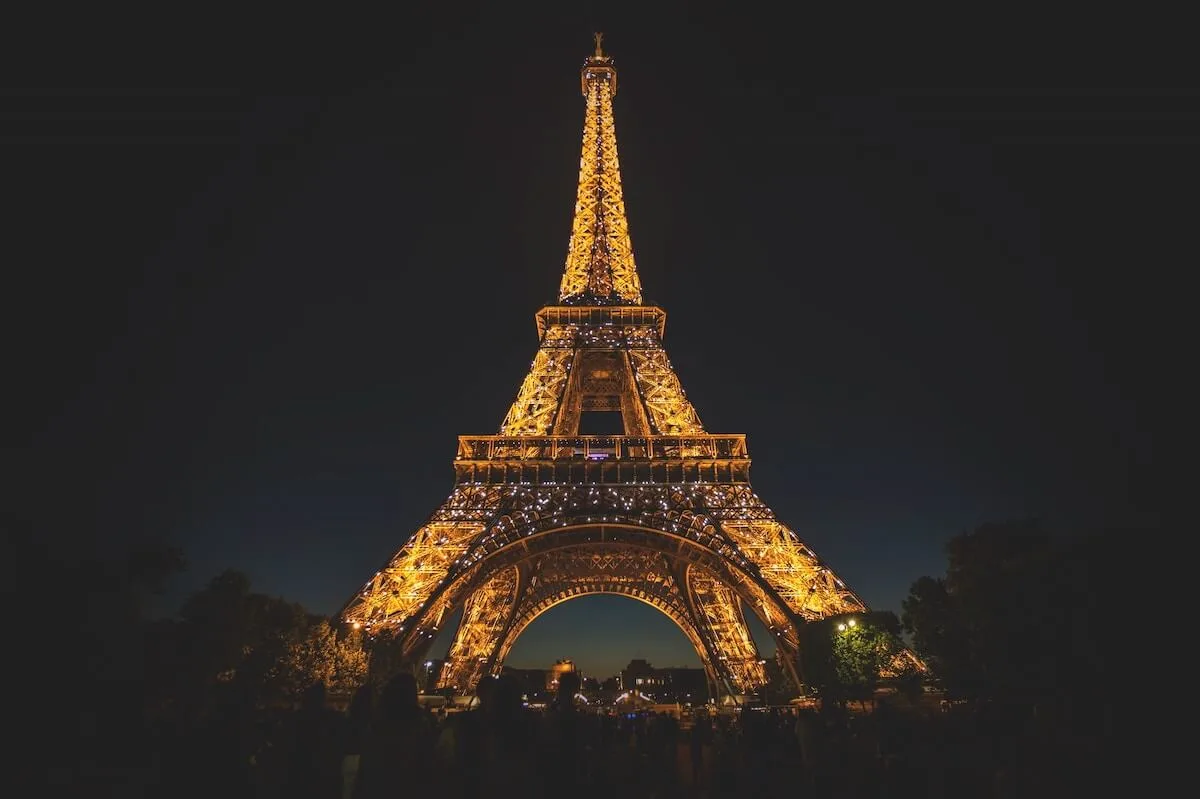 Disclaimer: Almost all posts on this site contain affiliate links, and this one featuring 27 Famous Paris Landmarks is no different. This means that if you click on any of the links in this post (and make a purchase) I may receive a small commission at absolutely no cost to you. Each post is carefully crafted to (hopefully!) answer all your questions and recommendations are made where we believe they will improve your trip and help with your planning. As such we thank you in advance should you decide to click & buy. Read my full Disclosure here.
Disclaimer: Almost all posts on this site contain affiliate links, and this one featuring 27 Famous Paris Landmarks is no different. This means that if you click on any of the links in this post (and make a purchase) I may receive a small commission at absolutely no cost to you. Each post is carefully crafted to (hopefully!) answer all your questions and recommendations are made where we believe they will improve your trip and help with your planning. As such we thank you in advance should you decide to click & buy. Read my full Disclosure here.
Map of 27 Famous Paris Landmarks
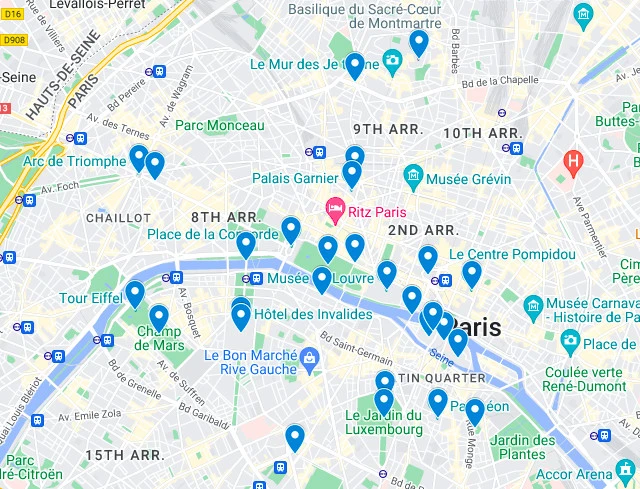 Our Map of the 27 Famous Landmarks in Paris is interactive – just click the map, or this link, and get directions between each of the incredible landmarks to visit during your time in the French capital.
Our Map of the 27 Famous Landmarks in Paris is interactive – just click the map, or this link, and get directions between each of the incredible landmarks to visit during your time in the French capital.
27 Famous Paris Landmarks You Don’t Want to Miss
Eiffel Tower
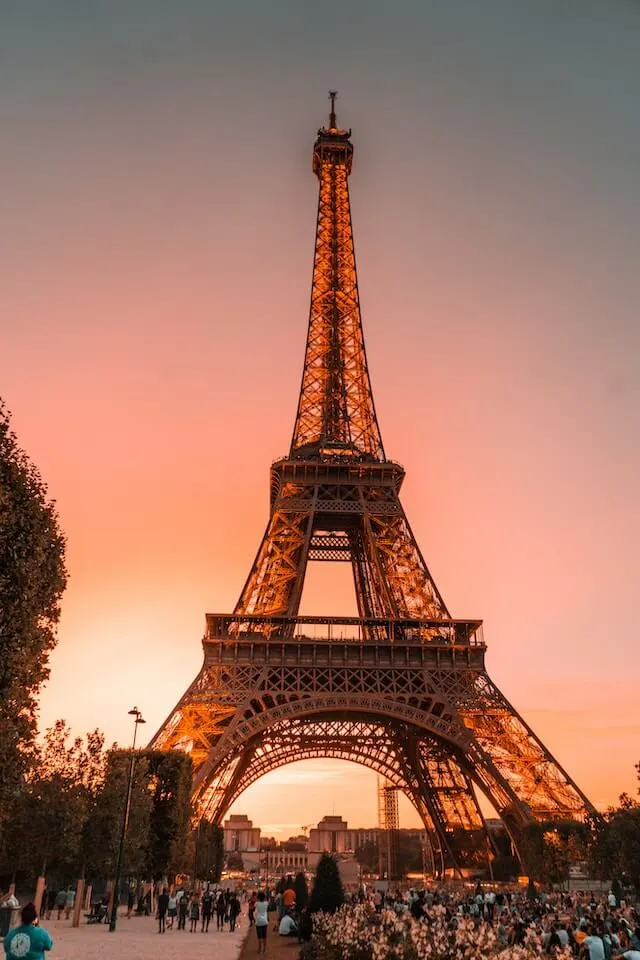 The Eiffel Tower, located in the 7th arrondissement is undoubtedly one of the most iconic landmarks of Paris and a symbol of France worldwide. It was designed by Gustave Eiffel and built in 1889 as the centerpiece of the World’s Fair to commemorate the 100th anniversary of the French Revolution – and was originally only meant to be temporary!
The Eiffel Tower, located in the 7th arrondissement is undoubtedly one of the most iconic landmarks of Paris and a symbol of France worldwide. It was designed by Gustave Eiffel and built in 1889 as the centerpiece of the World’s Fair to commemorate the 100th anniversary of the French Revolution – and was originally only meant to be temporary!
Despite its current status as a beloved cultural icon, the tower was initially met with controversy. Many Parisians considered the tower an eyesore and protested its construction, calling it “a gigantic black smokestack” and a “metal asparagus.” Nonetheless, it went ahead and was the tallest man-made structure in the world until the Chrysler Building was built in New York City in 1930.
Today, it attracts millions of visitors each year and has become an enduring symbol of the French capital, featured in countless films, photographs, and works of art.
The tower has also served as the site of several significant events, including the opening of the Paris Universal Exposition in 1900, the arrival of American troops during World War I, and numerous New Year’s Eve celebrations.
Its cultural significance and architectural beauty have made it a UNESCO World Heritage Site and a must-see destination for anyone visiting Paris. And if you want to go to the top – skiptheline tickets are an absolute must, especially during the summer months to make sure you don’t have to queue for hours!
Notre Dame Cathedral
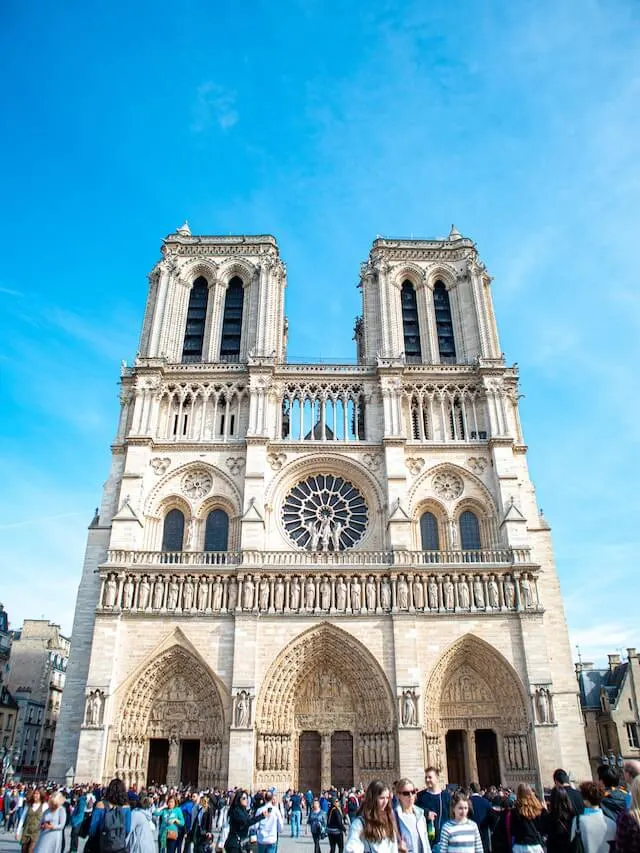 Notredame de Paris, located in the 4th arrondissement, is undoubtedly one of the most famous landmarks in Paris, with a rich history and cultural significance. The cathedral’s construction began in 1163 and took over 200 years to complete. It was a feat of medieval engineering and remains one of the finest examples of French Gothic architecture. Its intricate facade features stunning carvings and sculptures, including the famous gargoyles that adorn its rooftop.
Notredame de Paris, located in the 4th arrondissement, is undoubtedly one of the most famous landmarks in Paris, with a rich history and cultural significance. The cathedral’s construction began in 1163 and took over 200 years to complete. It was a feat of medieval engineering and remains one of the finest examples of French Gothic architecture. Its intricate facade features stunning carvings and sculptures, including the famous gargoyles that adorn its rooftop.
The cathedral has played an important role in French history, from hosting royal coronations to serving as the backdrop for Victor Hugo’s famous novel “The Hunchback of Notre Dame.”
Unfortunately, the cathedral suffered a devastating fire in 2019, causing significant damage to the roof and spire. The incident sparked an outpouring of grief and solidarity from people around the world. The French government launched a major fundraising campaign to restore the cathedral, and work is underway to repair and rebuild the damaged parts of the building.
Despite the damage, the cathedral remains a must-visit landmark in Paris, with millions of visitors each year coming to admire its beauty and historical significance.
– 35 Essential Paris Travel Tips to Know Before You Go
– 20 FREE Things to do in Paris
– 3 Days in Paris – A Perfect Itinerary (Written by a Local!)
– 35 UNMISSABLE Things to Do in Paris This Summer (inc. Map)
– 16 Day Trips from Paris that are totally worth the $$
– 70 Basic French Words & Phrases for Travelers
– 60+ Hidden Gems in Paris (inc. Map)
– 35+ Things to do on a Rainy Day in Paris
– Inspiring Quotes About Paris (inc. some in French, with translations!)
Arc de Triomphe
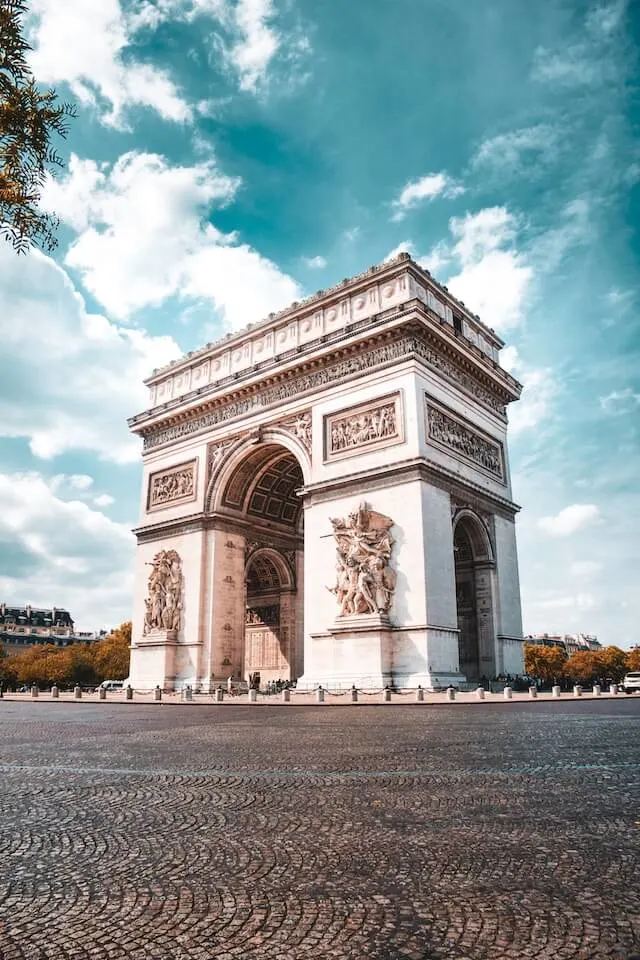 The Arc de Triomphe is one of the most iconic landmarks in Paris, located at the western end of the Champs-Élysées in the 8th arrondissement. Standing at 50 meters tall, it is a triumphal arch that honors the soldiers who fought and died for France during the French Revolution and the Napoleonic Wars.
The Arc de Triomphe is one of the most iconic landmarks in Paris, located at the western end of the Champs-Élysées in the 8th arrondissement. Standing at 50 meters tall, it is a triumphal arch that honors the soldiers who fought and died for France during the French Revolution and the Napoleonic Wars.
The Arc was commissioned by Napoleon Bonaparte in 1806 and was completed in 1836. It is adorned with sculptures that depict historical battles and events, as well as a flame that burns continuously in memory of the unknown soldier.
The Arc de Triomphe has played an important role in French history, serving as a symbol of national pride and military strength. It is also the site of important national events and ceremonies, including the annual Bastille Day military parade.
In recent years, the Arc de Triomphe has been the site of some controversies. In 2018, protestors associated with the “yellow vest” movement vandalized the monument, spray-painting graffiti and starting fires. The monument has also been the site of protests against police brutality and racial injustice.
Despite these incidents, the Arc de Triomphe remains an important symbol of France’s rich history and enduring national identity. Visitors can climb to the top for a panoramic view of Paris and take in the stunning architecture and sculptures that make this monument one of the most famous landmarks to visit in Paris.
Place de la Concorde
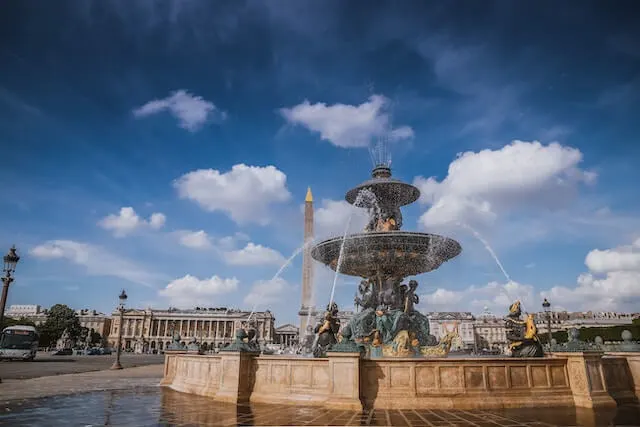 The Place de la Concorde is a significant Parisian landmark and public square that has played a central role in the city’s history.
The Place de la Concorde is a significant Parisian landmark and public square that has played a central role in the city’s history.
Originally named Place Louis XV, it was created in the 18th century as a part of a major urban planning project by King Louis XV. The square was the site of numerous events, including the execution of King Louis XVI and Marie Antoinette during the French Revolution.
It was later renamed Place de la Concorde to symbolize a new era of peace and harmony. The square’s centerpiece is the Luxor Obelisk, a 3,300-year-old Egyptian obelisk that was gifted to France in the 19th century. The two fountains on either side of the obelisk, featuring sculptures of mythical creatures, are also major attractions.
In addition to its historical significance, the Place de la Concorde is also an important transportation hub in Paris and is surrounded by several noteworthy buildings, including the Hôtel de Crillon and the French Naval Ministry.
– If you can afford to travel, you can afford – and should definitely buy – Travel Insurance
– For Car Rental (anywhere in the world!) we recommend Discover Cars
– When it comes to packing we’ve reviewed the best Hardside Luggage & Backpacks for Women
PLUS
– Travel Essentials for Women, Backpacking Essentials for Everyone, and Travel Gadgets to make life easier.
Pont Alexandre III
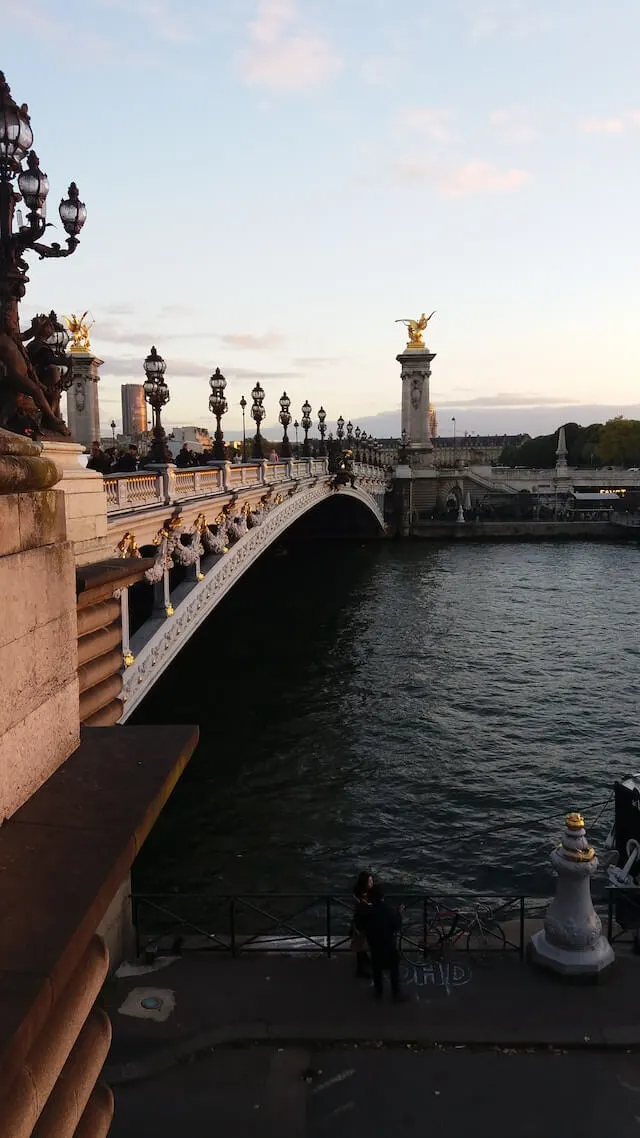 The Pont Alexandre III, connecting the 7th and 8th arrondissements, is one of the most iconic bridges in Paris, known for its stunning design and intricate details. The bridge was constructed for the 1900 World Fair, and it is named after Tsar Alexander III, who signed the Franco-Russian Alliance in 1892.
The Pont Alexandre III, connecting the 7th and 8th arrondissements, is one of the most iconic bridges in Paris, known for its stunning design and intricate details. The bridge was constructed for the 1900 World Fair, and it is named after Tsar Alexander III, who signed the Franco-Russian Alliance in 1892.
This beautiful bridge is a popular tourist destination, offering stunning views of the Eiffel Tower and the Seine River.
The bridge’s design, featuring Art Nouveau lamps, sculptures of cherubs, and gold-leaf embellishments, was inspired by the French Renaissance and the Louis XIV style.
The bridge has also been the site of several important historical events, including the victory parade at the end of World War I, and has been featured in numerous films and music videos.
Louvre Museum
 The Louvre Museum is located in the heart of Paris in the 1st arrondissement and was originally built as a fortress in the 12th century. It was later converted into a royal palace and eventually transformed into a museum during the French Revolution. Today, it is one of the most popular tourist attractions in Paris, with visitors from all over the world coming to admire its impressive collection of art and artifacts, spanning thousands of years of history.
The Louvre Museum is located in the heart of Paris in the 1st arrondissement and was originally built as a fortress in the 12th century. It was later converted into a royal palace and eventually transformed into a museum during the French Revolution. Today, it is one of the most popular tourist attractions in Paris, with visitors from all over the world coming to admire its impressive collection of art and artifacts, spanning thousands of years of history.
The museum is home to more than 35,000 works of art, including paintings, sculptures, decorative arts, and archaeological objects. Its collection includes works from ancient civilizations, as well as from the Renaissance, Baroque, and Romantic periods.
However, it is the glass pyramids at the Louvre Museum which make it worthy of inclusion in our iconic landmarks of Paris list. These three glass and metal structures were designed by the renowned architect I.M. Pei and were unveiled in 1989 as part of a major renovation of the museum.
The largest pyramid is made up of 673 glass panes and stands 21.6 meters tall. The two smaller pyramids are located adjacent to the main pyramid and serve as entrances to the museum’s underground reception area.
The pyramids have been the subject of both praise and criticism since their construction. While some people view them as a modern and innovative addition to the historic museum, others believe that they clash with the classical architecture of the Louvre’s main building. Despite the controversy, the pyramids have become an iconic symbol of the Louvre and are a popular attraction for visitors to Paris.
Sacre Coeur
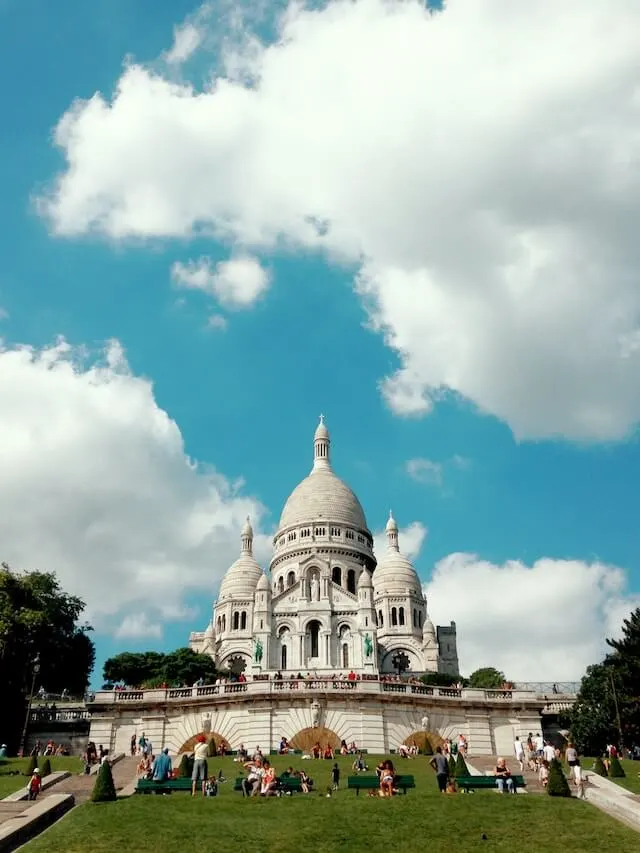 The Sacrécœur Basilica is a famous landmark located in the 18th arrondissement of Paris. It is a stunning basilica that sits atop a hill in the Montmartre neighborhood. The building was constructed between 1875 and 1914, and its unique architecture features both Byzantine and Romanesque elements. It was designed by architect Paul Abadie and is made of white stone that gleams in the sunlight.
The Sacrécœur Basilica is a famous landmark located in the 18th arrondissement of Paris. It is a stunning basilica that sits atop a hill in the Montmartre neighborhood. The building was constructed between 1875 and 1914, and its unique architecture features both Byzantine and Romanesque elements. It was designed by architect Paul Abadie and is made of white stone that gleams in the sunlight.
The cultural significance of Sacre Coeur is profound, as it is one of the most important religious sites in Paris. The basilica attracts millions of visitors every year who come to marvel at its beauty and to experience the peaceful and spiritual atmosphere of the church.
If not for the building itself, but also for the view over Paris at night, it’s easy to see why the Sacre Couer is one of the most famous monuments in Paris.
Champs-Élysées
 The Champs-Élysées is one of the most famous avenues in the world and is located in the 8th arrondissement of Paris. The avenue stretches for 1.9 kilometers from the Arc de Triomphe to the Place de la Concorde and is lined with trees, shops, and cafes.
The Champs-Élysées is one of the most famous avenues in the world and is located in the 8th arrondissement of Paris. The avenue stretches for 1.9 kilometers from the Arc de Triomphe to the Place de la Concorde and is lined with trees, shops, and cafes.
It was originally created in the 17th century as a pathway through the Tuileries Gardens, but it wasn’t until the 19th century that it became the grand boulevard that we know today.
The cultural significance of the Champs-Élysées is immense, as it is a symbol of Parisian elegance and style. It is home to some of the most famous high-end fashion brands in the world, including Louis Vuitton, Chanel, and Dior.
The avenue is also the site of many important events and celebrations, such as the annual Bastille Day military parade and the final stage of the Tour de France.
Île de la Cité
The Île de la Cité, in the 4th arrondissement, is one of the two remaining natural islands in the Seine River and is considered the birthplace of Paris. The island has a rich history, dating back to the Roman era, and has been the site of some of the most significant events in French history.
The Notre-Dame Cathedral, one of the most famous Gothic cathedrals in the world, is located on the island and attracts millions of visitors each year. The Sainte-Chapelle, a stunning Gothic chapel with stunning stained glass windows, is another popular attraction. The Conciergerie, a former royal palace turned prison during the French Revolution, is also located on the island and is open for visitors to explore.
The Île de la Cité is not only a popular tourist destination but also a cultural and historic center of the city, with a unique atmosphere and charm that draws visitors from all over the world.
Galeries Lafayette
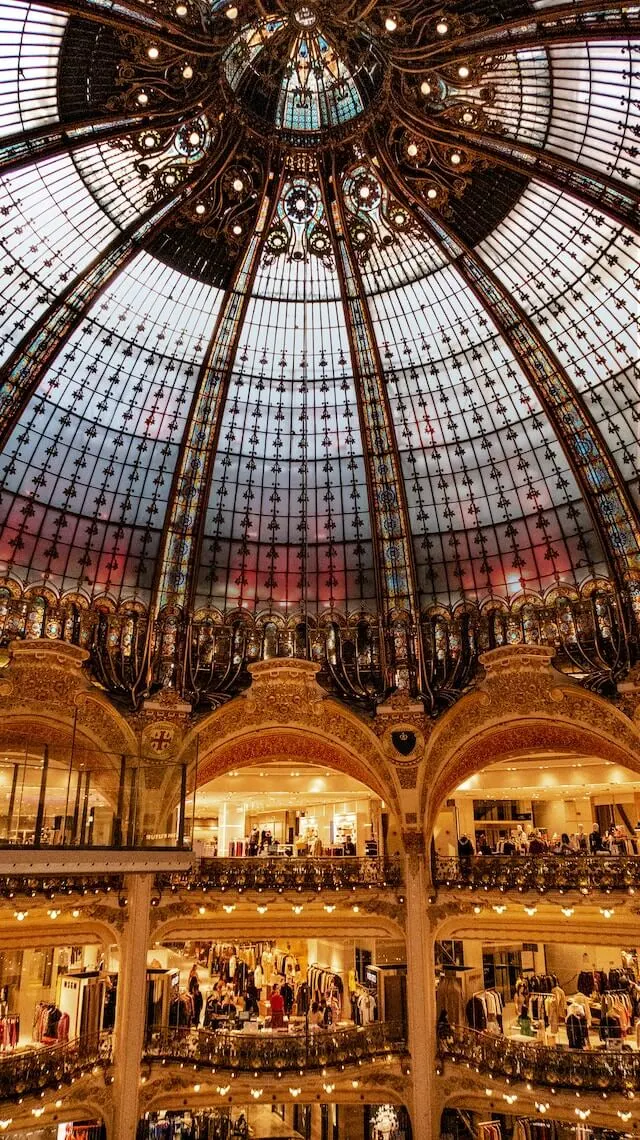 The Galeries Lafayette is not only a popular shopping destination but also a historic landmark in Paris, located in the 9th arrondissement. Founded in 1894, the department store is known for its impressive Art Nouveau dome and ornate balconies.
The Galeries Lafayette is not only a popular shopping destination but also a historic landmark in Paris, located in the 9th arrondissement. Founded in 1894, the department store is known for its impressive Art Nouveau dome and ornate balconies.
The store has been expanded over the years, adding new buildings and features, such as the stunning stained glass dome and the rooftop terrace, which offers panoramic views of the city.
The Galeries Lafayette has become an emblem of French elegance and luxury, attracting both locals and tourists alike.
Pont Neuf
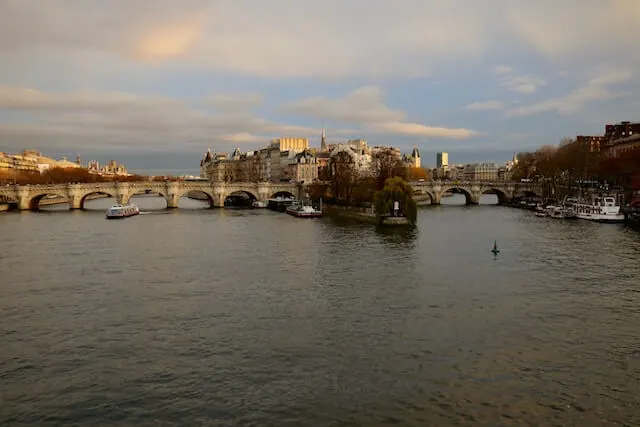 Pont Neuf is located in the 1st arrondissement of Paris and is one of the most famous landmarks in the city. Despite its name, it is the oldest standing bridge across the River Seine. It was commissioned by King Henry III in the late 16th century and was finally completed in 1607 under the reign of King Henry IV. The bridge features 12 arches and is decorated with 381 stone masks and various sculptures, including representations of the four seasons and the king on horseback.
Pont Neuf is located in the 1st arrondissement of Paris and is one of the most famous landmarks in the city. Despite its name, it is the oldest standing bridge across the River Seine. It was commissioned by King Henry III in the late 16th century and was finally completed in 1607 under the reign of King Henry IV. The bridge features 12 arches and is decorated with 381 stone masks and various sculptures, including representations of the four seasons and the king on horseback.
The Pont Neuf has played an important role in the history of Paris, serving as a stage for public executions and as a gathering place for political protests. It also served as inspiration for artists, including French impressionist painter Claude Monet, who painted a series of artworks featuring the bridge.
RELATED: Other beautiful bridges in Paris include Pont Alexandre III (featured above), Pont Diéna, Pont des Arts & Pont au Change
Moulin Rouge
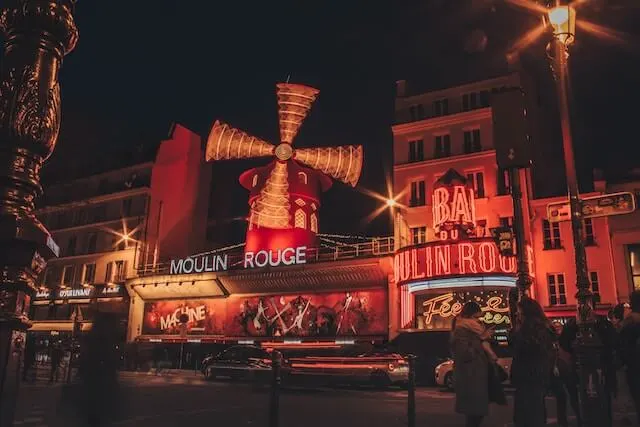 The Moulin Rouge, is one of the most famous landmarks in Paris and is known worldwide for its extravagant shows and performances. The cabaret is located in the Pigalle district of Paris in the 18th arrondissement, a historic neighborhood known for its nightlife and entertainment.
The Moulin Rouge, is one of the most famous landmarks in Paris and is known worldwide for its extravagant shows and performances. The cabaret is located in the Pigalle district of Paris in the 18th arrondissement, a historic neighborhood known for its nightlife and entertainment.
The Moulin Rouge was founded in 1889 and quickly became a popular attraction for locals and tourists alike. It is renowned for being the birthplace of the can-can dance, a high-energy dance that involves acrobatic movements and flashing petticoats.
The Moulin Rouge has been visited by many famous figures throughout history, including artist Henri de Toulouse-Lautrec, who created many iconic posters for the venue.
The building has undergone several renovations and restorations over the years, but its iconic red windmill has remained a symbol of Parisian nightlife. Today, the Moulin Rouge continues to attract visitors with its impressive stage shows, talented performers, and extravagant costumes.
Sainte Chapelle
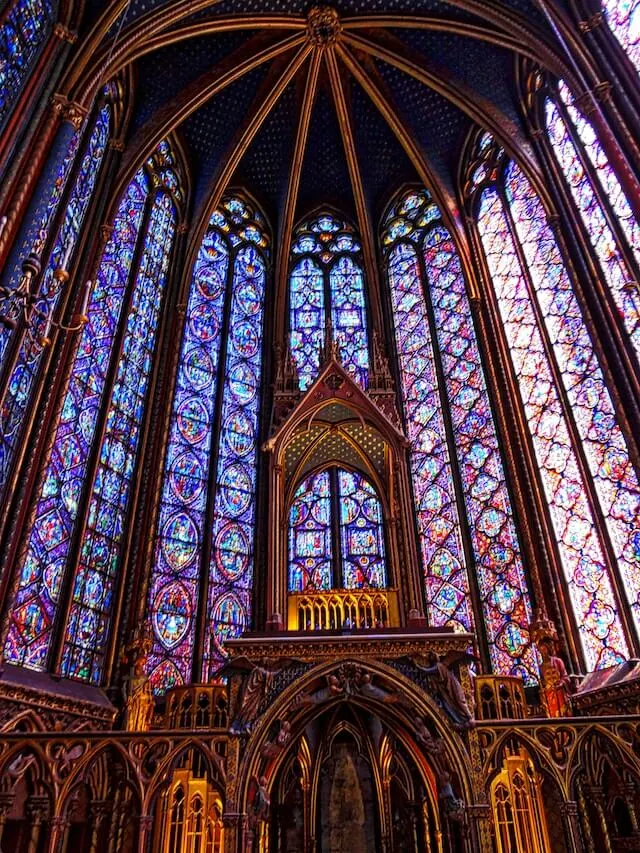 Sainte Chapelle, located in the 4th arrondissement, is a magnificent Parisian landmark that never fails to impress visitors with its beauty. Constructed in the 13th century, the chapel was built to house a collection of Christian relics, including the Crown of Thorns.
Sainte Chapelle, located in the 4th arrondissement, is a magnificent Parisian landmark that never fails to impress visitors with its beauty. Constructed in the 13th century, the chapel was built to house a collection of Christian relics, including the Crown of Thorns.
The chapel was commissioned by King Louis IX of France, who wanted to create a space that was worthy of the precious relics it would contain.
The Sainte Chapelle is renowned for its stunning stained glass windows, which cover almost every inch of the upper chapel’s walls. The vibrant, jewel-toned glass depicts scenes from the Old and New Testaments, and the intricate patterns and designs are truly breathtaking.
The chapel has survived numerous threats throughout the centuries, including damage during the French Revolution and World War II.
Today, visitors can marvel at the Sainte Chapelle’s beauty and learn about its history through guided tours and audio guides. The chapel is located on the Île de la Cité, in the heart of Paris, and is a must-see landmark for anyone interested in Gothic architecture and religious history.
Palais Garnier
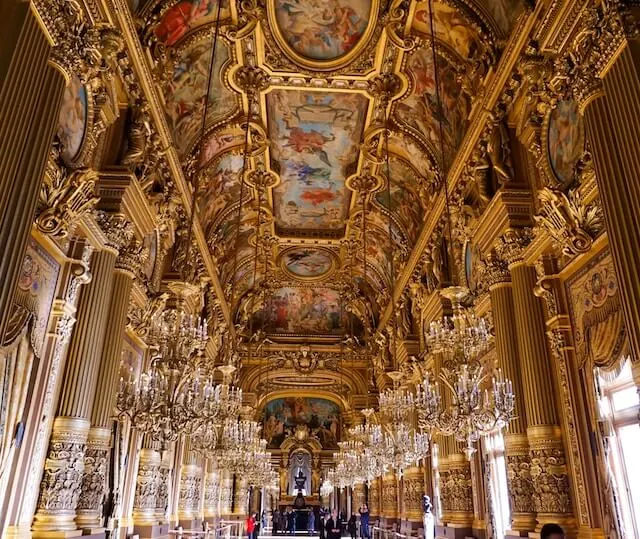 The Palais Garnier (sometimes referred to as the Opéra Garnier), located in the 9th arrondissement, is one of the most iconic landmarks of Paris and a symbol of the city’s artistic and cultural heritage.
The Palais Garnier (sometimes referred to as the Opéra Garnier), located in the 9th arrondissement, is one of the most iconic landmarks of Paris and a symbol of the city’s artistic and cultural heritage.
Completed in 1875 during the reign of Napoleon III, the opera house was designed by architect Charles Garnier, who won a competition to create a building that would reflect the glory of the Second Empire. The result is a grand structure that combines classicism and ornate decoration, with its iconic facade adorned with marble columns, sculptures and friezes.
The interior of the Palais Garnier is equally impressive, with its lavish foyers, grand staircase, and the famous Chagall ceiling, which depicts scenes from famous operas. The auditorium is renowned for its rich decoration, including gold leaf and plush velvet seating, and can accommodate over 2,000 people.
Over the years, the Palais Garnier has been the setting for many important cultural events and has hosted some of the world’s most famous performers. Today, it continues to be one of the most prestigious opera houses in the world, attracting visitors from all over the globe who come to admire its beauty and attend its world-class performances.
Musée d’Orsay
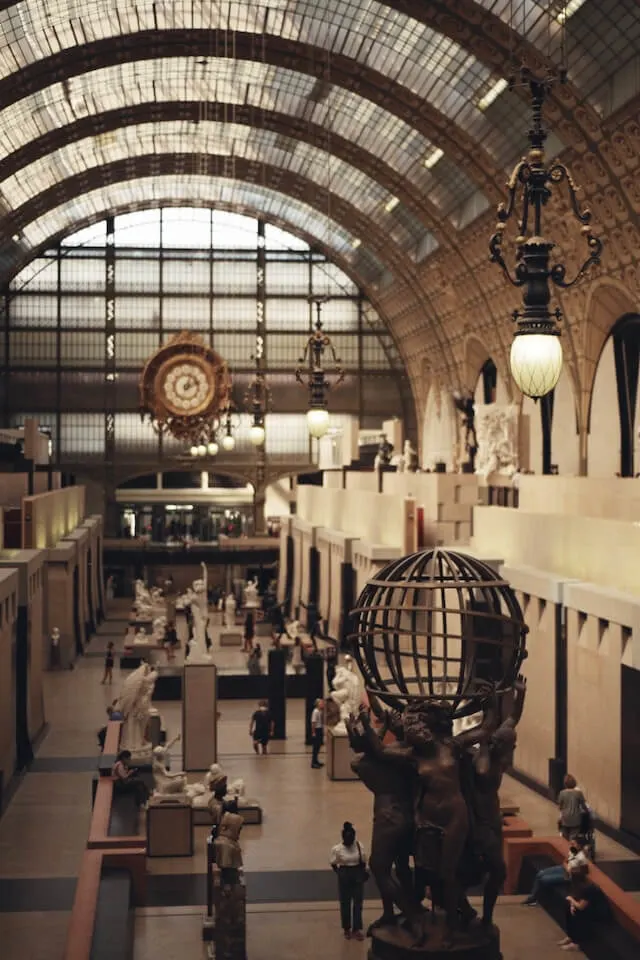 The Musée d’Orsay, located in the 7th arrondissement, is considered a landmark in Paris due to its impressive collection of art, its stunning architecture, and its fascinating history. T
The Musée d’Orsay, located in the 7th arrondissement, is considered a landmark in Paris due to its impressive collection of art, its stunning architecture, and its fascinating history. T
he museum is located in a former Beaux-Arts railway station, the Gare d’Orsay, which was built for the 1900 World Fair. However, the station was quickly deemed inadequate for modern trains and was closed in 1939. In the 1970s, plans were made to turn the abandoned station into a museum, and after extensive renovations, the Musée d’Orsay opened its doors to the public in 1986.
Today, the Musée d’Orsay is home to one of the largest collections of Impressionist and Post-Impressionist art in the world, with works by some of the most famous artists of the era, including Van Gogh, Monet, Manet, Degas, and Renoir. The museum also features collections of decorative arts, sculpture, and photography, as well as temporary exhibitions that showcase other periods of art history. The building’s stunning architecture, with its high ceilings, ornate moldings, and giant clocks, adds to the museum’s unique atmosphere, making it a must-visit destination for anyone interested in art or history.
Centre Pompidou
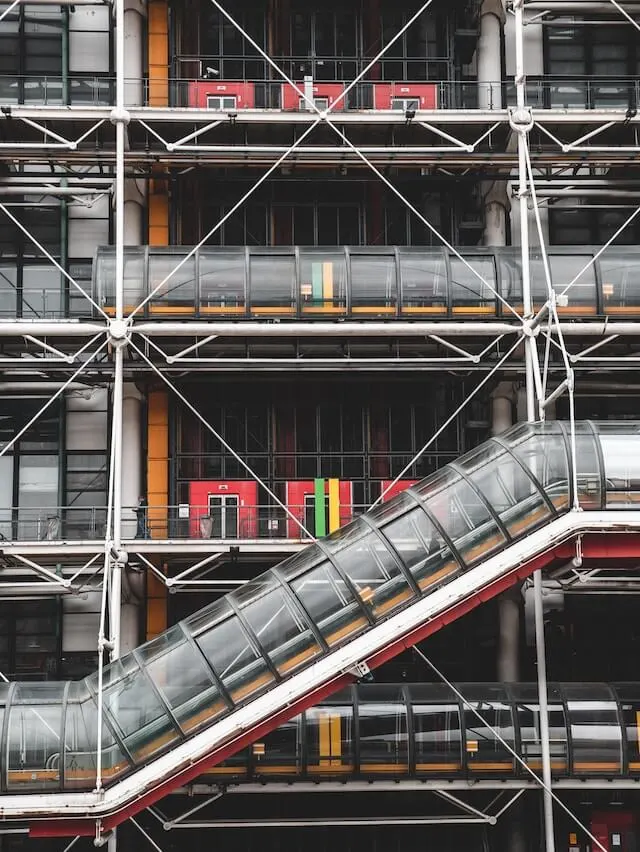 The Centre Pompidou, named after former French President Georges Pompidou and located in the 4th arrondissement, was inaugurated in 1977 and quickly became a symbol of the modern and avant-garde cultural identity of Paris.
The Centre Pompidou, named after former French President Georges Pompidou and located in the 4th arrondissement, was inaugurated in 1977 and quickly became a symbol of the modern and avant-garde cultural identity of Paris.
Designed by architects Renzo Piano and Richard Rogers, the building features an exposed skeleton of brightly colored tubes, escalators on the exterior, and a panoramic view of the city from the top floor.
The museum’s collection is one of the largest of modern and contemporary art in Europe, with over 100,000 works by artists such as Picasso, Matisse, Warhol, and Pollock. In addition to the permanent collection, the Pompidou Centre regularly hosts temporary exhibitions, performances, and workshops for all ages.
The Centre Pompidou has been credited with democratizing access to contemporary art and culture, making it accessible to a wider audience. It is also one of the most visited cultural institutions in France, attracting millions of visitors each year. And the building itself has become a cultural icon, a testament to the power of design to create a landmark that has become an integral part of the Parisian skyline and identity.
Luxembourg Palace and Gardens
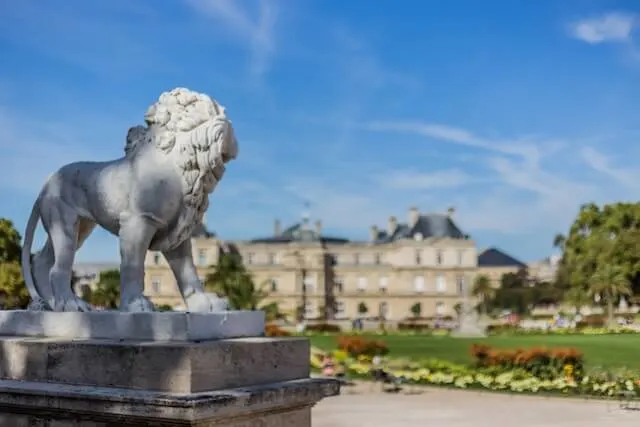 The Luxembourg Palace and Gardens in Paris is one of the most famous landmarks in the city. It is located in the 6th arrondissement and has a rich history. The palace was originally built in the 17th century for Marie de’ Medici, the widow of King Henry IV. The palace has been used for various purposes over the years, including as a prison during the French Revolution. In 1795, it became the home of the French Senate, a role it still serves today.
The Luxembourg Palace and Gardens in Paris is one of the most famous landmarks in the city. It is located in the 6th arrondissement and has a rich history. The palace was originally built in the 17th century for Marie de’ Medici, the widow of King Henry IV. The palace has been used for various purposes over the years, including as a prison during the French Revolution. In 1795, it became the home of the French Senate, a role it still serves today.
The Luxembourg Gardens (Jardins du Luxembourg) were designed by the same landscape architect who designed the gardens at Versailles, and they cover over 60 acres. Visitors can stroll along the tree-lined paths, relax by the fountains or ponds, or even rent a sailboat to sail on the small pond in the gardens. The gardens also feature several sculptures, including a replica of the Statue of Liberty.
The cultural significance of the Luxembourg Palace and Gardens is immense. The palace has been the site of important events in French history, and the gardens have been a gathering place for artists, writers, and politicians for centuries. The gardens have also inspired works of art, including paintings by Monet and other Impressionist artists.
Les Invalides & The Musée de l’Armée
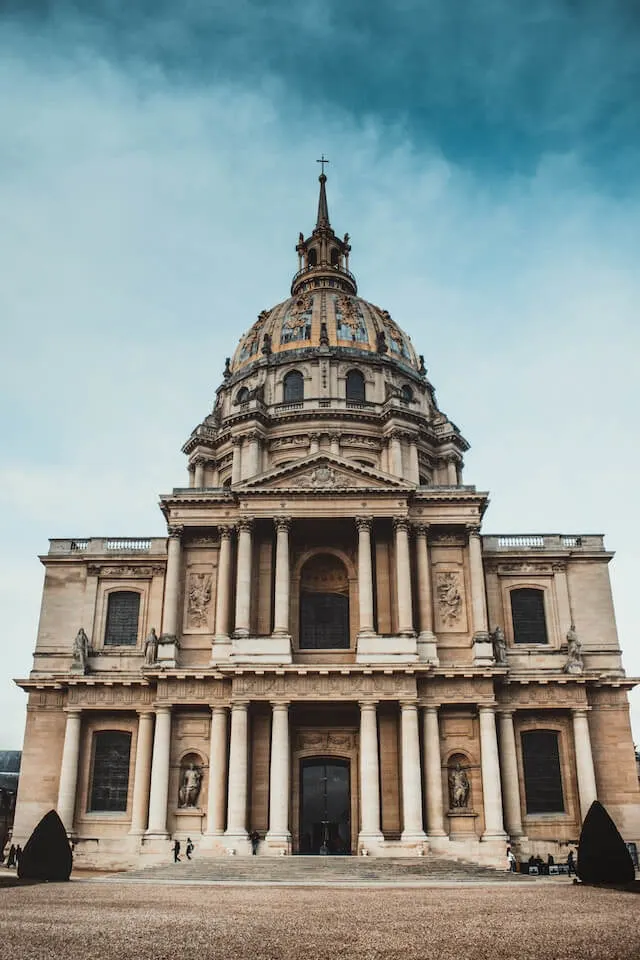 Les Invalides (sometimes referred to as the Hotel des Invalides), located in the 7th arrondissement of Paris, was commissioned by Louis XIV in the 17th century as a hospital and home for disabled and aged soldiers. However, it has since been transformed into a military museum – The Musée de l’Armée (Army Museum) and a burial site for French military heroes, including Napoleon Bonaparte. The museum houses over 500,000 objects and documents that chronicle French military history from the Middle Ages to the present day.
Les Invalides (sometimes referred to as the Hotel des Invalides), located in the 7th arrondissement of Paris, was commissioned by Louis XIV in the 17th century as a hospital and home for disabled and aged soldiers. However, it has since been transformed into a military museum – The Musée de l’Armée (Army Museum) and a burial site for French military heroes, including Napoleon Bonaparte. The museum houses over 500,000 objects and documents that chronicle French military history from the Middle Ages to the present day.
One of the most famous landmarks of Les Invalides is the Église du Dôme, which was designed by Jules Hardouin-Mansart in the 17th century and features a gilded dome that has become an iconic symbol of Paris. It was here that Napoleon’s remains were initially laid to rest in 1861, and visitors can view his tomb, which is surrounded by statues of the French military’s greatest leaders.
Les Invalides has significant cultural significance in France as a testament to the country’s military history and the bravery of its soldiers. However, there have been some controversies surrounding the site, particularly its association with Napoleon, who is viewed by some as a controversial historical figure.
Arènes de Lutèce
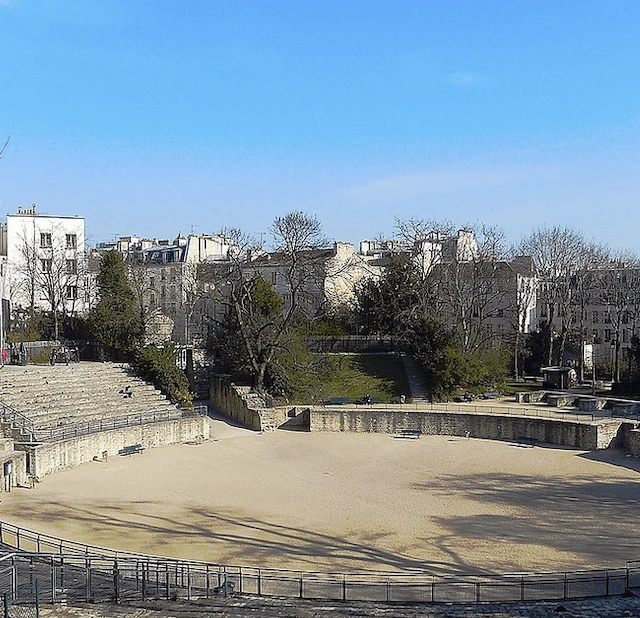 The Arènes de Lutèce are located in the 5th arrondissement of Paris and are considered one of the city’s most unique landmarks. They are the remnants of a large amphitheater that was built in the 1st century AD during the Roman Empire.
The Arènes de Lutèce are located in the 5th arrondissement of Paris and are considered one of the city’s most unique landmarks. They are the remnants of a large amphitheater that was built in the 1st century AD during the Roman Empire.
After the fall of the Roman Empire, the amphitheater was abandoned and covered up by the expanding city of Paris, only to be rediscovered in the 19th century during a construction project. Today, visitors can explore the ruins and imagine what life was like for the ancient Romans who once attended events at the amphitheater.
The site has great cultural significance as it is a rare example of Roman architecture in the heart of Paris, and it remains an important historical and cultural landmark that attracts visitors from around the world.
Jardin des Tuileries
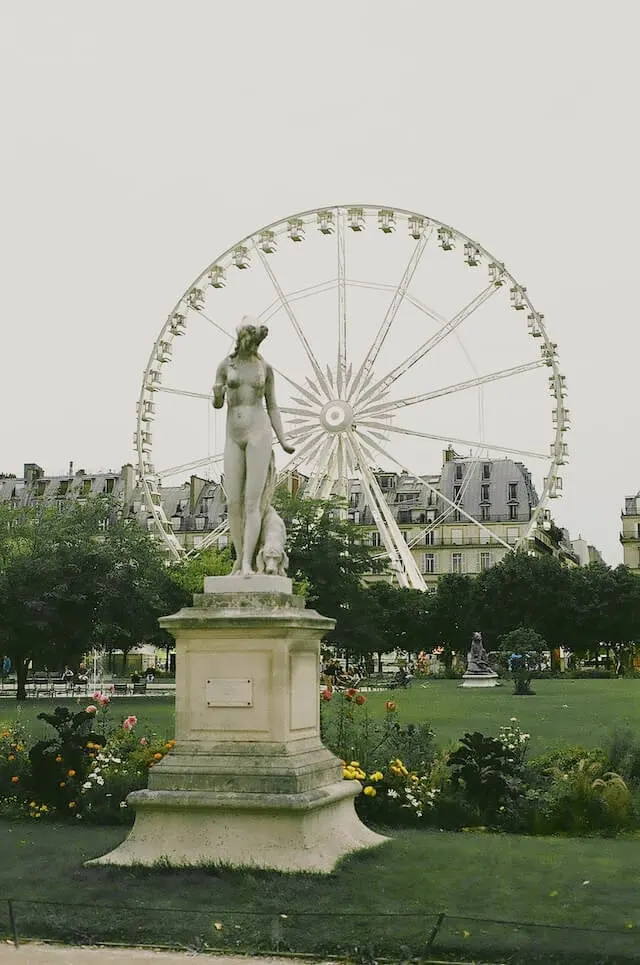 The Jardin des Tuileries is a historic Parisian landmark that spans 22.4 hectares in the heart of the city’s 1st arrondissement.
The Jardin des Tuileries is a historic Parisian landmark that spans 22.4 hectares in the heart of the city’s 1st arrondissement.
The garden was created in the mid-16th century by Catherine de’ Medici as a formal garden for the Tuileries Palace. Over the years, the garden has undergone several transformations, including being converted into a public park in the 17th century. Today, it is a popular destination for both locals and tourists alike, providing a peaceful haven in the bustling city.
The garden is home to numerous sculptures, including works by Auguste Rodin, as well as fountains and a large pond where visitors can rent small boats. In addition to its cultural significance, the garden has also been the site of several controversial events, including the execution of Louis XVI during the French Revolution and the burning of many Tuileries Palace artworks in 1871 during the Paris Commune uprising.
Despite these events, the Jardin des Tuileries remains an iconic symbol of Parisian elegance and sophistication.
Les Halles
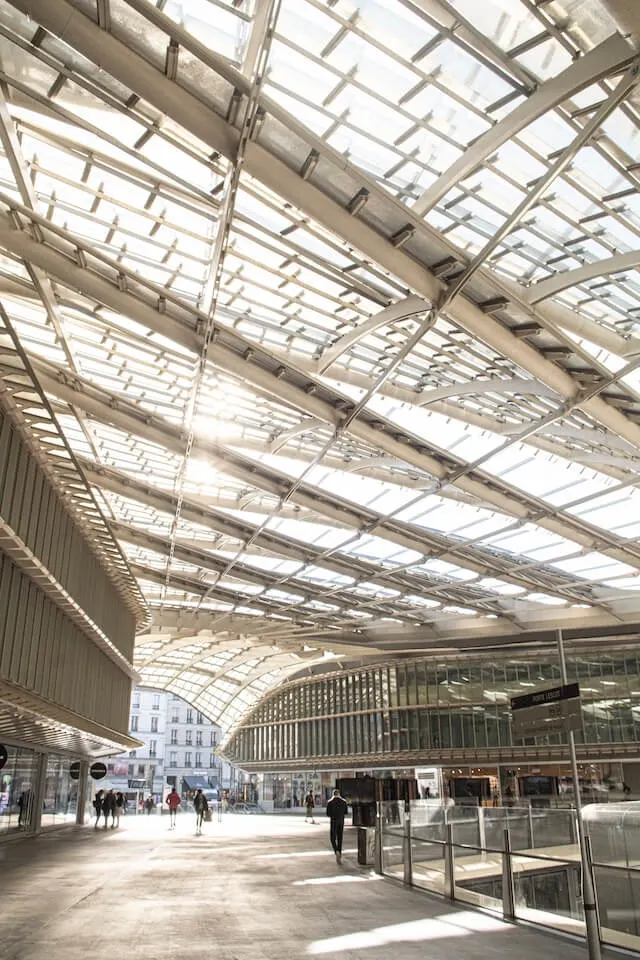 Les Halles is located in the 1st arrondissement of Paris, and it has a rich history dating back to the 12th century when it was established as a marketplace. Over the centuries, it grew in size and importance, becoming the central market for food and produce in Paris. However, by the mid-20th century, the market had become overcrowded and unsanitary, leading to its eventual closure in 1971.
Les Halles is located in the 1st arrondissement of Paris, and it has a rich history dating back to the 12th century when it was established as a marketplace. Over the centuries, it grew in size and importance, becoming the central market for food and produce in Paris. However, by the mid-20th century, the market had become overcrowded and unsanitary, leading to its eventual closure in 1971.
After its closure, the area was redeveloped into a modern shopping and dining district, with the creation of the Forum des Halles shopping center and the addition of new pedestrian zones and green spaces. The redevelopment project was met with controversy, as many criticized the new design and lamented the loss of the historic market. However, Les Halles has become a popular destination for locals and tourists alike, with its trendy shops, diverse cuisine, and vibrant atmosphere.
Culturally, Les Halles is significant as a symbol of Parisian commerce and gastronomy, as well as for its association with the city’s history and heritage.
Rue de Rivoli
Rue de Rivoli is one of the most famous streets in Paris, and is a popular destination for both locals and tourists. The street was named after the Battle of Rivoli, which took place in Italy in 1797 and was won by Napoleon Bonaparte. Rue de Rivoli was designed by Napoleon I as a way to connect the eastern and western parts of the city and to create a grand boulevard that would rival the Champs-Élysées. It was built in the 19th century and features stunning Haussmannian architecture with its uniform façades and ornate details.
ue de Rivoli is located in the 1st arrondissement, which is home to some of the most famous landmarks in Paris, including the Louvre Museum and the Tuileries Gardens. The street runs parallel to the River Seine and is easily accessible by public transportation.
Aside from its stunning architecture, Rue de Rivoli is known for its high-end shopping. Visitors can find everything from luxury fashion brands to department stores and souvenir shops. The street is also home to several famous landmarks, including the Hôtel de Ville and the Saint-Jacques Tower.
La Conciergerie
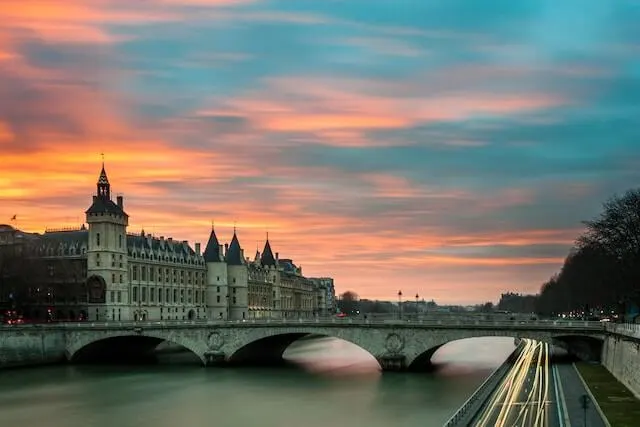 La Conciergerie is a historic building located on the Western end of Île de la Cité, in the 1st arrondissement, of Paris.
La Conciergerie is a historic building located on the Western end of Île de la Cité, in the 1st arrondissement, of Paris.
Originally a royal palace, it later became a prison during the French Revolution, with many famous prisoners held within its walls, including Marie Antoinette. The building is known for its stunning Gothic architecture, including the iconic clock tower and the Salle des Gens d’Armes, a grand hall that once served as a royal banquet hall.
Today, visitors can explore the building’s history and learn about its role in the French Revolution, as well as admire the intricate stonework and impressive medieval architecture.
Banks of the Seine
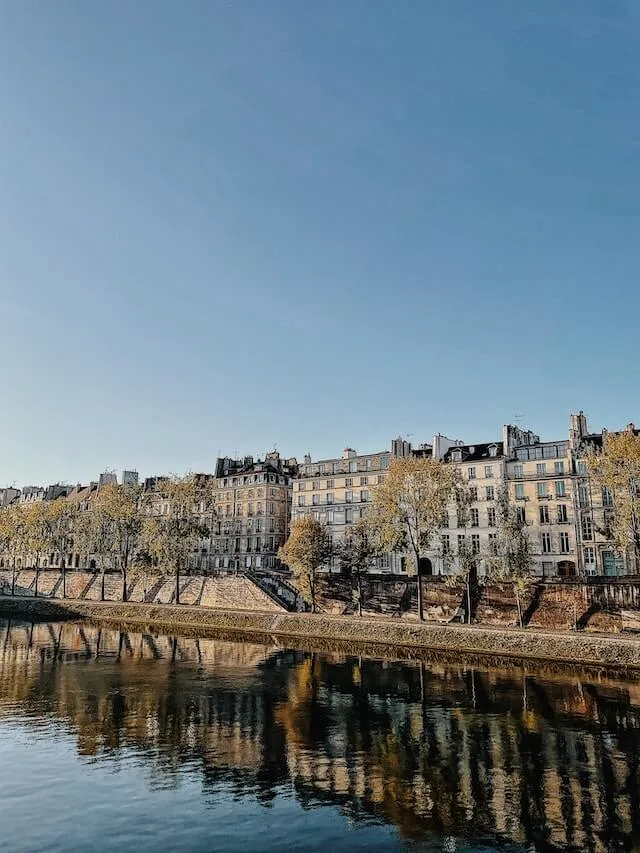 The Banks of the Seine are one of the most famous Parisian landmarks, running through the heart of the city on both the Left and Right Banks.
The Banks of the Seine are one of the most famous Parisian landmarks, running through the heart of the city on both the Left and Right Banks.
The Left Bank of the river is lined with beautiful architecture, quaint cafes, and bookstores. It has a rich history, having been home to artists, intellectuals, and writers such as Hemingway and Fitzgerald during the 1920s. Today, it is a hub for art, culture, and nightlife, with numerous museums and galleries, as well as the famous Shakespeare and Company bookstore.
The Right Bank, or Rive Droite, on the other hand, is famous for its luxurious shopping districts, iconic landmarks such as the Louvre Museum and the Arc de Triomphe, many prestigious institutions such as the Palais Garnier, home of the Paris Opera, and the Musée d’Orsay, and its vibrant nightlife. It is also home to the central business district of Paris, known as La Défense, which is famous for its modern architecture and skyscrapers.
Pantheon
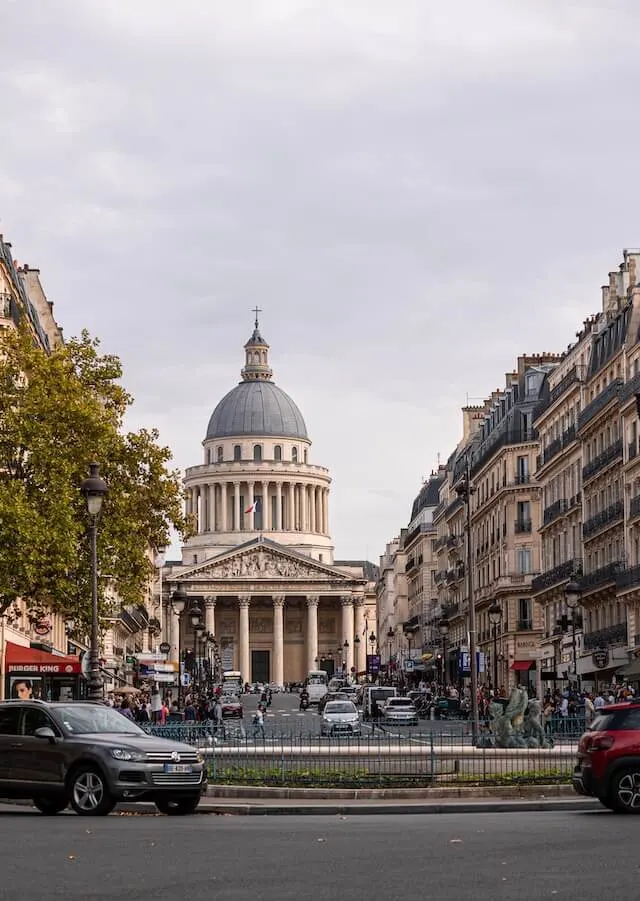 The Panthéon is an iconic neoclassical monument located in the Latin Quarter of Paris, in the 5th arrondissement. Originally built as a church dedicated to Saint Genevieve, it was later converted into a secular mausoleum housing the remains of France’s greatest citizens, including Voltaire, Rousseau, Victor Hugo, and Marie Curie.
The Panthéon is an iconic neoclassical monument located in the Latin Quarter of Paris, in the 5th arrondissement. Originally built as a church dedicated to Saint Genevieve, it was later converted into a secular mausoleum housing the remains of France’s greatest citizens, including Voltaire, Rousseau, Victor Hugo, and Marie Curie.
The Panthéon is known for its impressive dome and grand interior, which features beautiful frescoes and sculptures. While the building has undergone various transformations throughout its history, it remains a significant cultural and architectural landmark in Paris.
Montparnasse Tower (Tour Montparnasse)
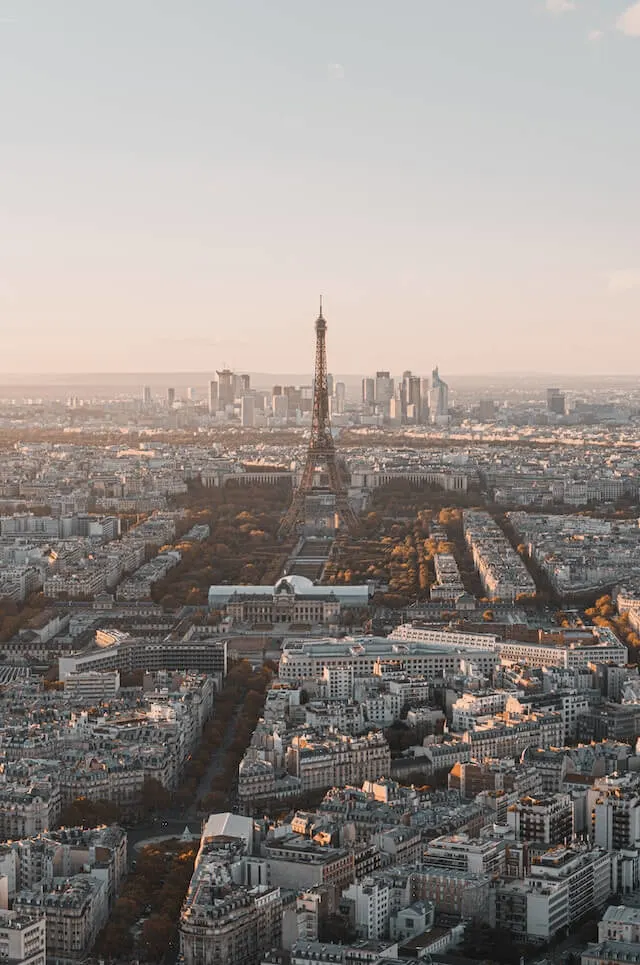 Montparnasse Tower, also known as Tour Montparnasse, is one of the best-kept secrets of Paris. Located in the 15th arrondissement, it is the only skyscraper in the outside of the CBD, rising 210 meters above the ground. Its construction was controversial due to its impact on the city’s skyline – but the incredible view from the top can easily asway any fears people had.
Montparnasse Tower, also known as Tour Montparnasse, is one of the best-kept secrets of Paris. Located in the 15th arrondissement, it is the only skyscraper in the outside of the CBD, rising 210 meters above the ground. Its construction was controversial due to its impact on the city’s skyline – but the incredible view from the top can easily asway any fears people had.
Today, visitors can take the fastest elevator in Europe to the top floor for stunning panoramic views of the city, and despite initial criticism, the tower has become a cultural icon of Paris and attracts millions of tourists each year.
Parc du Champ de Mars
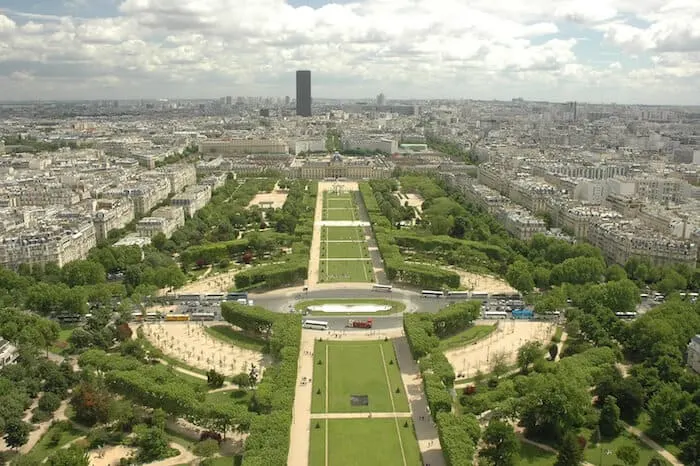 Parc du Champ de Mars is a large public park located in the 7th arrondissement of Paris.
Parc du Champ de Mars is a large public park located in the 7th arrondissement of Paris.
It was originally created in the late 17th century as a military parade ground but is now a popular destination for picnics, relaxation, and outdoor events. The park is also home to the Eiffel Tower, which was built for the 1889 Exposition Universelle and has become a symbol of Parisian culture and engineering.
Parc du Champ de Mars has been the site of many important cultural and political events, including the Fête de la Fédération during the French Revolution and the annual Bastille Day military parade.
And that’s a wrap! We hope this Paris travel guide to 25 Famous Paris Landmarks (inc. Map!) has been a huge help in planning your Paris trip, and if you know of anyone else that needs a little bit of inspiration or assistance in planning their Parisien getaway, please be sure to share on social media: Facebook, Flipboard, Twitter or grab the image from below for Pinterest. And remember – sharing is caring (and we thank you in advance!)
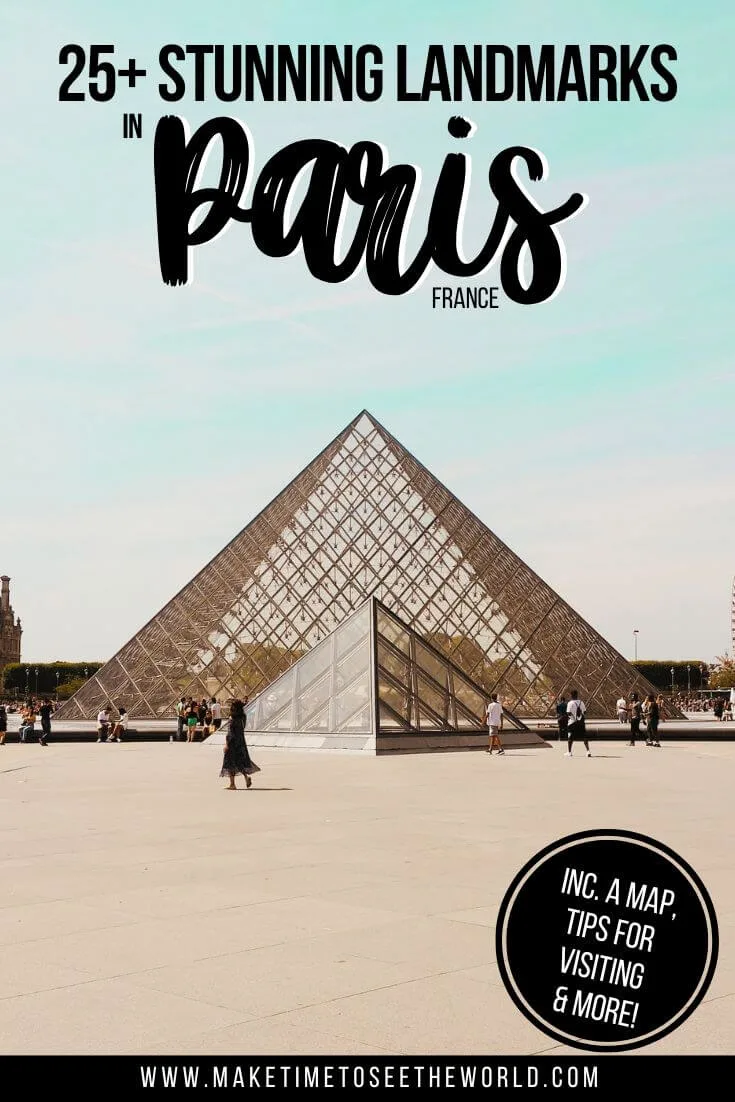
READY FOR MORE EUROPE TRAVEL INSPIRATION? YOU MIGHT BE INTERESTED IN THESE TRAVEL TIPS, TRAVEL HACKS, TRAVEL ARTICLES, TRAVEL DESTINATIONS GUIDES, SOLO TRAVEL GUIDES, TRAVELER RESOURCES AND RELATED POSTS ABOUT OTHER BEAUTIFUL CITIES IN EUROPE TO HELP YOU EXPLORE EUROPE AND TRAVEL THE WORLD:
- Italy: 20+ Best Places to Visit in Italy + Top Italy Travel Tips + Venice, Rome, Cinque Terre & Amalfi Coast!
- Spain: Best Places to Visit in Spain + Spain Travel Tips
- Road Trips Resources & Adventure Travel: Road Trip Packing List, Road Trip Tips, Road Trip Quotes & the Ultimate Road Trip Playlist (we’ve also go an Ultimate Travel Playlist for something a bit more general)
- Around the World: The Top Places to Visit in the USA + The Middle East + Asia inc. Hong Kong, Sri Lanka, South Korea + South Africa!
- Stylish and Affordable Travel Gear – The Best Carry on Luggage for Frequent Travelers, The Best Hardside Luggage for you road warriors, Travel Water Bottle to stay hydrated PLUS the best passport wallets & 40 Insanely Useful Backpacking Essentials to make sure you have everything you need.
Hi There! Thanks for reading my travel guide to Paris which features 25+ Famous Paris Landmarks You Don’t Want to Miss! I just wanted to let you know that this post may contain affiliate links, which means if you purchase something after clicking a link, I may get a small commission – which is at absolutely no cost to you. If you enjoyed this article and are going to be searching for some of the things I mention anyway, I would love it if you could click through from the links above & thank you in advance! Read my full disclosure here. And thank you for reading the MakeTimeToSeeTheWorld travel blog.
